Seven Questions Over Breakfast with Julia Denos
(with visits from authors Cecil Castellucci and Erica S. Perl)
 September 7th, 2010 by jules
September 7th, 2010 by jules
 For one of Julia Denos’s recent illustrated titles, Erica S. Perl’s Dotty, Publishers Weekly had this to say about her artwork: “Denos’s…paintings are an unadulterated delight, combining the naïf styling of scribbly children’s drawings for the creatures and the easy, playful elegance of pattern book illustrations from the 1950s.” I like this, because “unadulterated delight” would be a good description of my very first response to her art work, years ago, when I first discovered it. Just don’t call her illustrations “cute”; as you’ll see below in her responses to the Pivot Questionnaire, that may not be her favorite descriptor. But that’s just the thing about her artwork: On the surface, it seems light and cheery, what with her lush, luminescent watercolors, but look carefully. It’s not all easy-breezy sunny flowers and fashionable young ladies. Denos injects a just-right, subtle drama into her work. As one reviewer for Cecil Castellucci’s Grandma’s Gloves (the other of Julia’s 2010 illustrated titles) wrote, “she also shows a real gift for portraying both characters and a setting marked by loss.” And Julia’s other strong suit? Her distinctive, can-spot-it-from-a-million-miles-out-in-space style, all her own.
For one of Julia Denos’s recent illustrated titles, Erica S. Perl’s Dotty, Publishers Weekly had this to say about her artwork: “Denos’s…paintings are an unadulterated delight, combining the naïf styling of scribbly children’s drawings for the creatures and the easy, playful elegance of pattern book illustrations from the 1950s.” I like this, because “unadulterated delight” would be a good description of my very first response to her art work, years ago, when I first discovered it. Just don’t call her illustrations “cute”; as you’ll see below in her responses to the Pivot Questionnaire, that may not be her favorite descriptor. But that’s just the thing about her artwork: On the surface, it seems light and cheery, what with her lush, luminescent watercolors, but look carefully. It’s not all easy-breezy sunny flowers and fashionable young ladies. Denos injects a just-right, subtle drama into her work. As one reviewer for Cecil Castellucci’s Grandma’s Gloves (the other of Julia’s 2010 illustrated titles) wrote, “she also shows a real gift for portraying both characters and a setting marked by loss.” And Julia’s other strong suit? Her distinctive, can-spot-it-from-a-million-miles-out-in-space style, all her own.
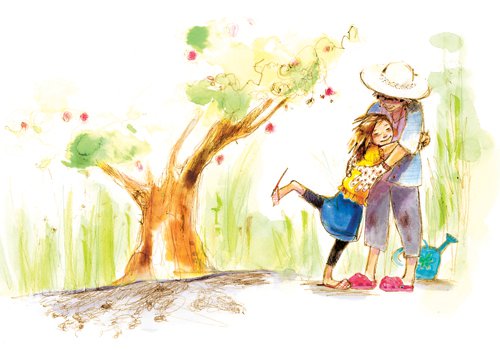
Speaking of those two picture book titles, have you seen them? Wonderful stuff. Both of ’em. YA author Cecil Castellucci had this to say when I asked her about Grandma’s Gloves (Candlewick, August 2010), her first picture book and the story of a young girl who loses her beloved grandmother and begins her own search for comfort, and Julia’s artwork for it:
Cecil: I wrote Grandma’s Gloves in 2000 right after my grandmother died. I wrote the book, and it has remained pretty much as I wrote it with only slight changes. I actually switched two of the pages late in the process after seeing Julia’s images and thinking the story flowed better. At first, our editor, Deb, was like, “what are you doing, Cecil?” But then it turned out perfect. Other than that, it’s a bit weird for me, because I don’t really have a picture book voice. I mean, obviously, I do, but as you know, I am much more comfortable with YA. But that is how this book and this particular story came out, and so there you go. And even though it was not the first book that I sold, it was the first book that opened the doors for me at Candlewick and I really think of it as the book that started my career, so I am so happy that it is out. Art-wise, it was really important to me that the Grandma be a modern day grandma. You know, one that wore crocs and had a cool haircut. Julia worked hard on getting the Grandma and the little girl to be sassy ladies, and when I saw the image of Grandma hosing the little girl (no, I know, they don’t have names; they are you and your grandma or me and my grandma), I knew that Julia had really nailed it. I love how soft the images are, and yet they are not too over the top for such a sensitive (and sad) story.
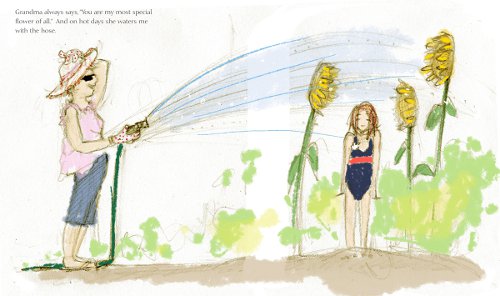
And then there’s Erica’s Dotty, also released this August (Abrams), the story of a young girl named Ida and her first day of school. Heading off to school with a long, blue string and her special, invisible friend Dotty attached to it, Ida and Dotty find out her classmates have also brought along other imaginary friends — but they don’t stay for long. As the year progresses, fewer imaginary friends come to class, and Ida wonders if Dotty is even welcome at school anymore. I asked Erica to weigh in, too, on this book and Julia’s work in it:
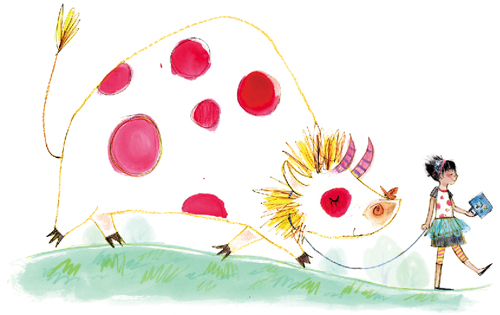
Erica: Dotty came from my own childhood relationships with imaginary friends. First, when I was about four, I had Sahti and Dahti, who were twins but were not the same ages (a detail adults found adorable), and several years later, I acquired an imaginary sheep. I kept the sheep to myself, though, because I had become more concerned with what people might think. My editor at Abrams, Susan Van Metre, loved Dotty from the start and snapped the manuscript up with surprising speed. (We usually have some back-and-forth over drafts before going to contract.) It took a long time to choose an illustrator, because we wanted someone who would just be perfect. Susan and Chad Beckerman, the book’s designer, and I had a lot of conversations about this illustrator and that one, but no one we found seemed like they could capture the book’s tone just right…until Julia. I give Chad credit for finding her. As soon as he showed me and Susan her work, the reaction was immediate: Yes! Can we get her? She’s perfect!
The first thing I told Julia when she agreed to illustrate Dotty was that I had been reading the story aloud, un-illustrated, at school visits, and I had discovered something unexpected. I had always thought of Dotty as a sheep or a goat (there are references to her horns and the fact that she nibbles on the classroom rug), but when I asked kids what Dotty was, each child had a different vision of her. I realized that Dotty probably wasn’t any one kind of creature, and she didn’t need to be. So I encouraged Julia to make Dotty—and all the other imaginary friends in the book—unique creatures. That’s where the fun really began. She did tons of character sketches, and Susan and Chad and I weighed in, and there was a lot of back and forth. It’s one thing I love about doing picture books — my experience at Abrams has been that the process is extremely collaborative. And Julia seemed to really enjoy getting feedback, which she would then incorporate into her drawings. The thing that I love the most is the way she foreshadowed the book’s ending in her art. Whenever I read the book to groups and share the surprise ending, we then go back through the book once more and see Julia’s magic — all the spots in which her illustrations hinted at what was coming without revealing the secret.
Julia joins me this morning for “strawberry blintzes and mint tea (or just lots of strawberries!)”… She’s even got the below images to show us how scrumptious our breakfast will be. Indeed. I’ll put a pot of strong coffee on for Erica and Cecil, too, and anyone else who wants to join us. I thank Julia—and Erica and Cecil—kindly for stopping by.

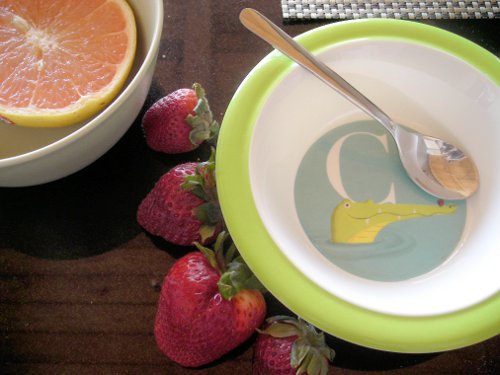
7-Imp: Are you an illustrator or author/illustrator?
Julia: Illustrator and author-in-training.
(Here’s a link to my blog about my first “book” cover in 1st grade after I just learned how to make sentences.)
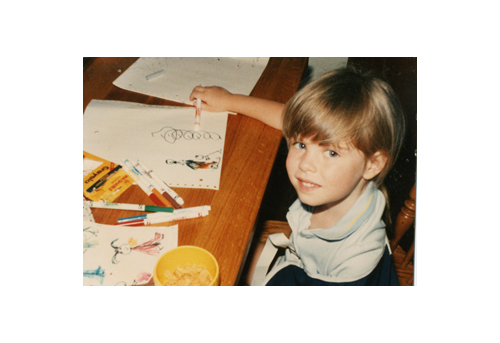


7-Imp: Can you list your books-to-date?
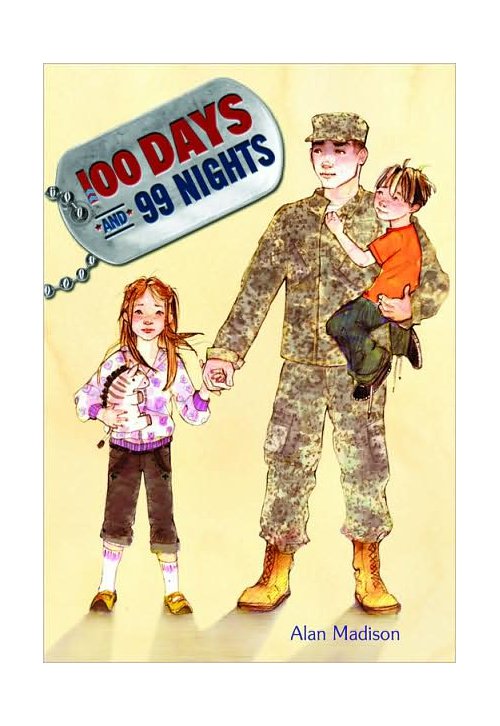

Julia:
- Sojourner Truth: Path to Glory by Peter Merchant : 2007
- The Sleepover Squad series by P.J. Denton : 2007
- Cornelia and the Great Snake Escape/Show-and-Tell Showdown by Pam Muñoz Ryan : 2009
- 100 Days and 99 Nights by Alan Madison : 2008
- My Little Girl by Tim McGraw : 2008
- Grandma’s Gloves by Cecil Castellucci : August 10, 2010
- Dotty by Erica S. Perl : August 1, 2010
- Just Being Audrey by Margaret Cardillo : coming January 2011
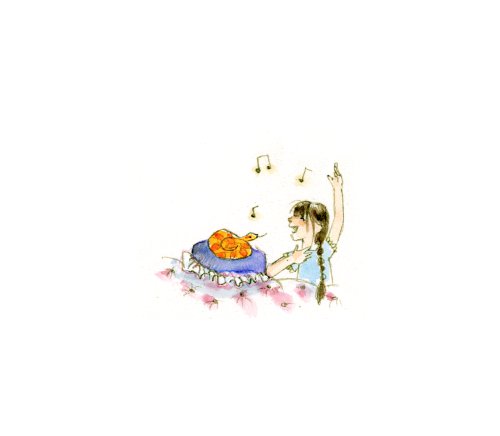



by Pam Muñoz Ryan
7-Imp: What is your usual medium, or––if you use a variety—your preferred one?
Julia: Watercolor is my first love!

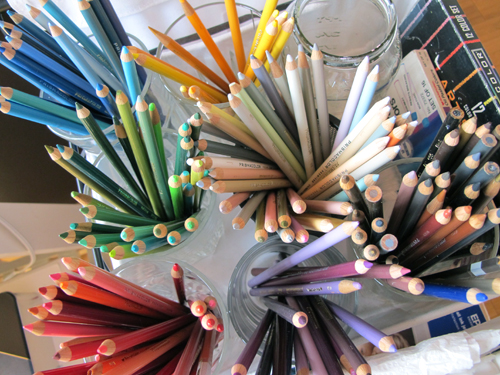
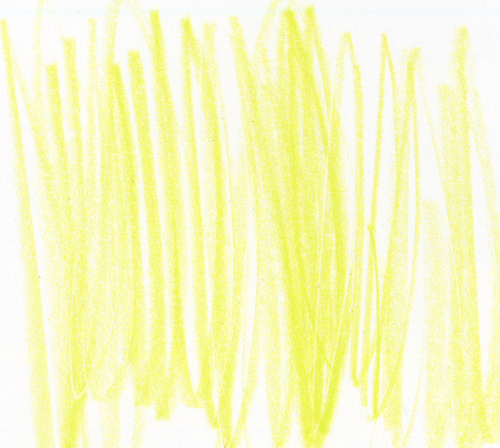
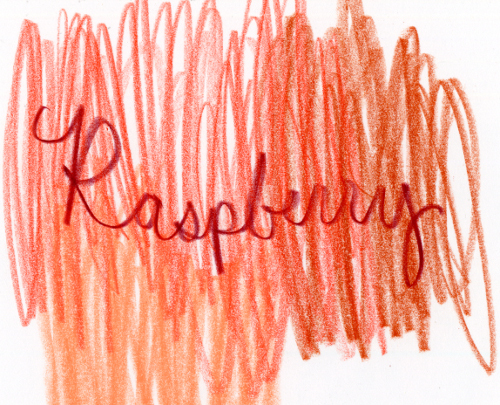
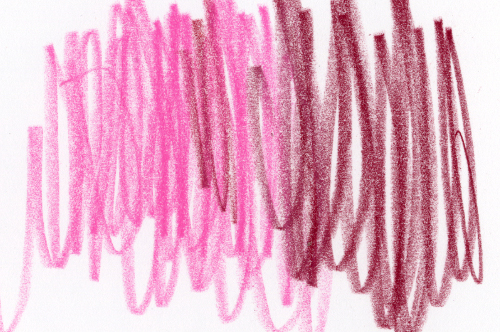
7-Imp: Where are your stompin’ grounds?



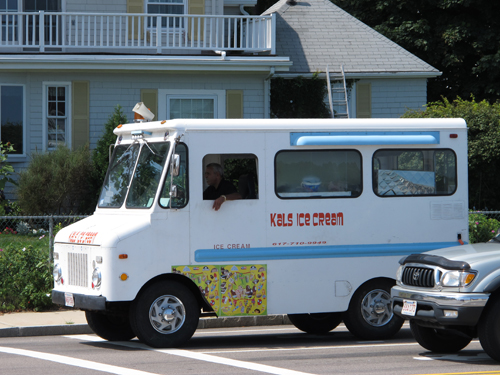
Julia: My husband and I just moved out of Boston and into a loft in Quincy, a town just outside of the city, still on the T’s Red Line. Quincy’s style is in-between: close to the city but far away enough to have a seaside with a boardwalk, ice cream trucks, and parks. The actual thing that convinced me to move here were the rotating “season” flags they hang all around town.

My favorite thing is to hop on the T down our street and end up here, in the city on the Esplanade, at sunset. Wednesdays they have public symphonies at the Hatch! I get a lot of inspiration from city adventures.




7-Imp: Can you briefly tell me about your road to publication?
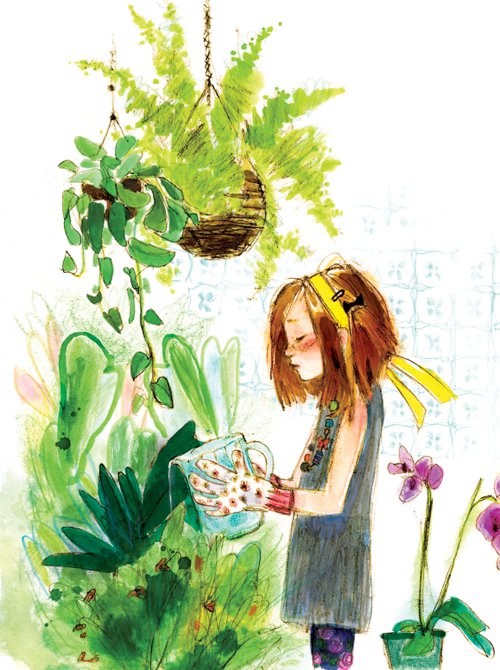
Julia: I left Boston with my B.F.A. in Illustration at the Art Insitute of Boston @Lesley University and moved back home to Cheshire, Connecticut. While I kept working on my art, I took a day job at the only place that was hiring in town: a florist. A florist would have been very lovely if my job wasn’t to spend the day throwing their neglected green house of dead plants into garbage cans (realized–duh–the place was going out of business!)…My sister started to work there, too, and together we tried to save a few little plants where the owner wouldn’t see, to bring them back to life!
One evening I was sweeping and received a message from an agent who had seen my website, inquiring about my work, and before long I had a book offer with them. Meanwhile, I had switched my day job from plant-mourner to bookseller at The Alphabet Garden, a children’s bookstore that had just opened in town. I worked on my first book on downtime at the store. It was an early reader, Sojourner Truth: Path to Glory, a biography of the abolitionist leader.
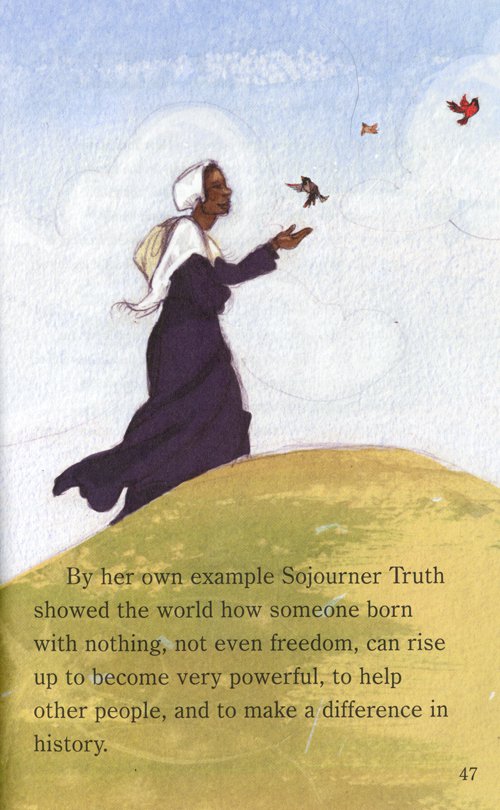
7-Imp: Can you please point readers to your web site and/or blog?
Julia: Website: www.juliadenos.com. Blog: thecinnamonrabbit.blogspot.com.
I also just linked up an official Facebook page, which I will update more frequently than the blog with the day-to-day and little sketches. Come say hi!

7-Imp: Any new titles/projects you might be working on now that you can tell me about?
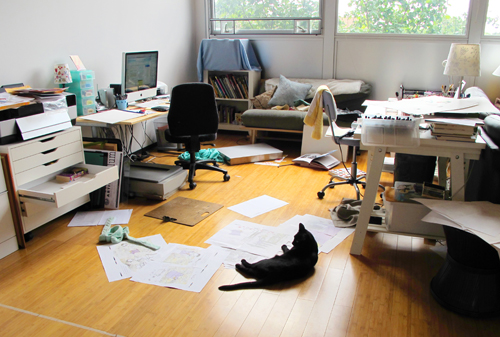
Julia: I have a lot of assignments going on all at once (and I have a messy studio to prove it!), and I’m heartily enjoying each of them. It’s fun to try out so many styles and author voices right now. I’m a little scatter-brained, so it’s a lesson in focus. It’s completely exciting!
I am repackaging two YA series for Simon and Schuster:
One about the eccentric Casson Family by Hilary McKay. I am totally enamored with this family. Can’t put the books down, and Rose Casson is my new hero!

…and the spunky 1980’s-originated Alice series by Phyllis Reynolds Naylor. This series makes me laugh out loud like a weirdo on the T!
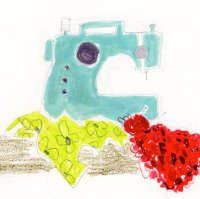 I am also right in the middle of art for a new picture book, I Had a Favorite Dress by Boni Ashburn, for Abrams. (Early concept work pictured left.)
I am also right in the middle of art for a new picture book, I Had a Favorite Dress by Boni Ashburn, for Abrams. (Early concept work pictured left.)
I’m also illustrating a novel for Random House, called Lexie by Audrey Couloumbis, and two YA novels too for Candlewick Press: a beautiful manuscript by Gigi Amateau and a funky journal/novel by Amy Hest.
I just published Grandma’s Gloves by Cecil Castellucci (Candlewick) and Dotty by Erica S. Perl (Abrams). They both just had August 2010 birthdays! If you want to read about the process behind Dotty, click over to my art director’s blog interview here.
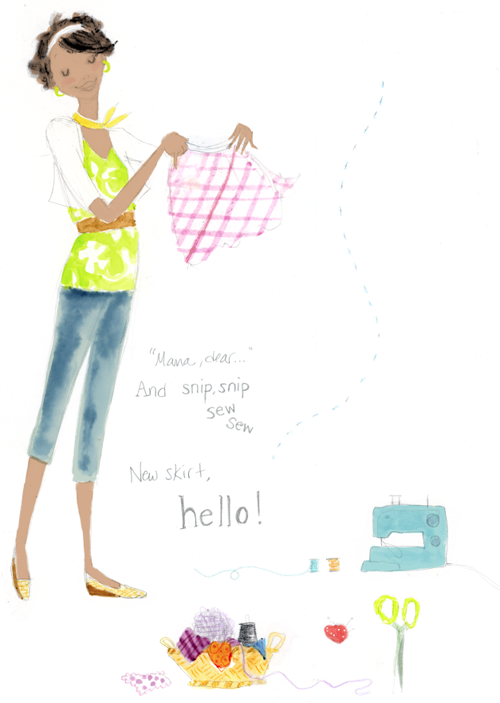
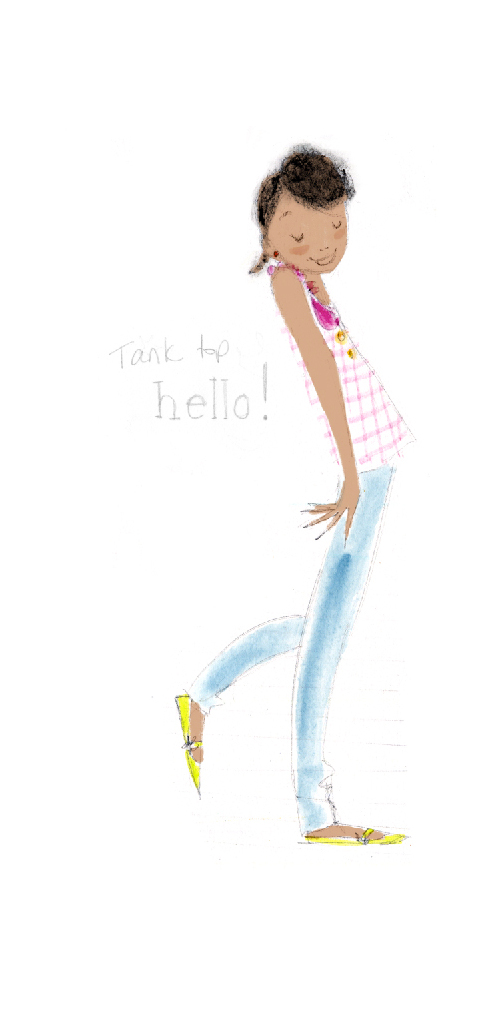
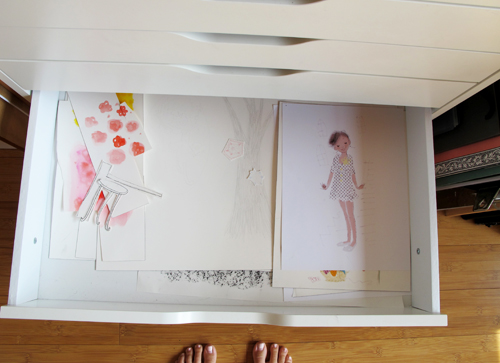
Grandma’s Gloves was a pivotal work for me stylistically, thanks to the astute guidance of Ann Stott, my designer at Candlewick. She really urged me to experiment. I really found my painting and drawing “voice” on this book and am continuing to take my cues from what I learned. The content of the story was deep-reaching for me, too. I talk here about making the book.

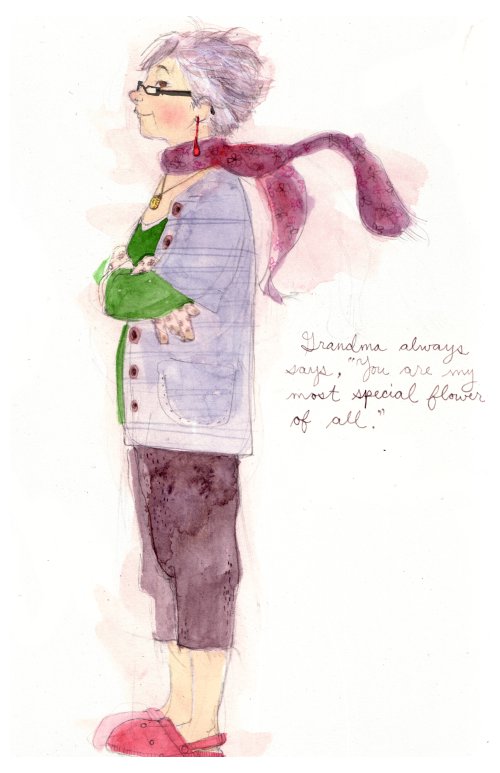
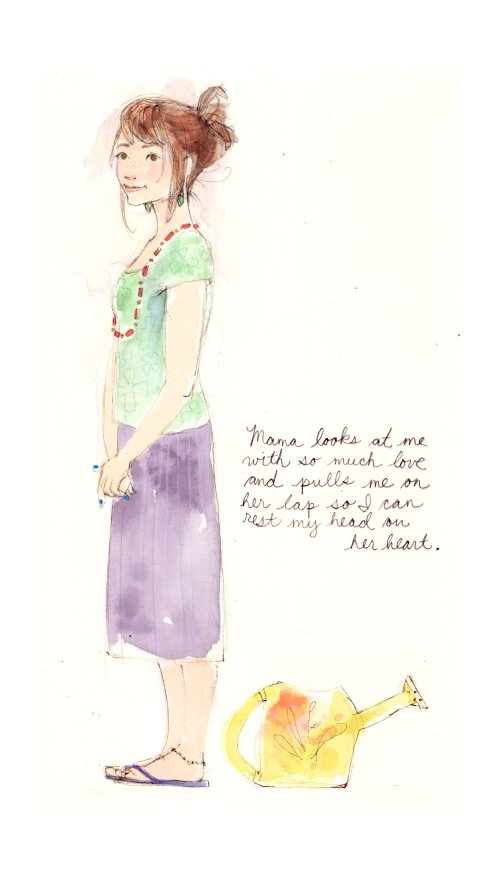

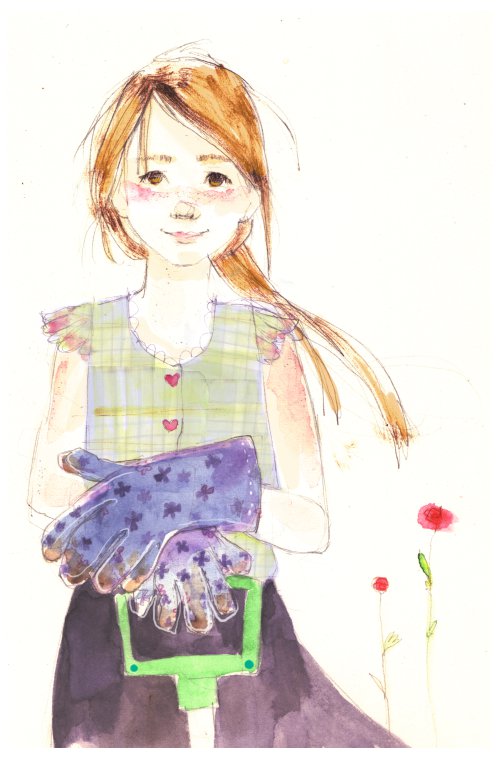
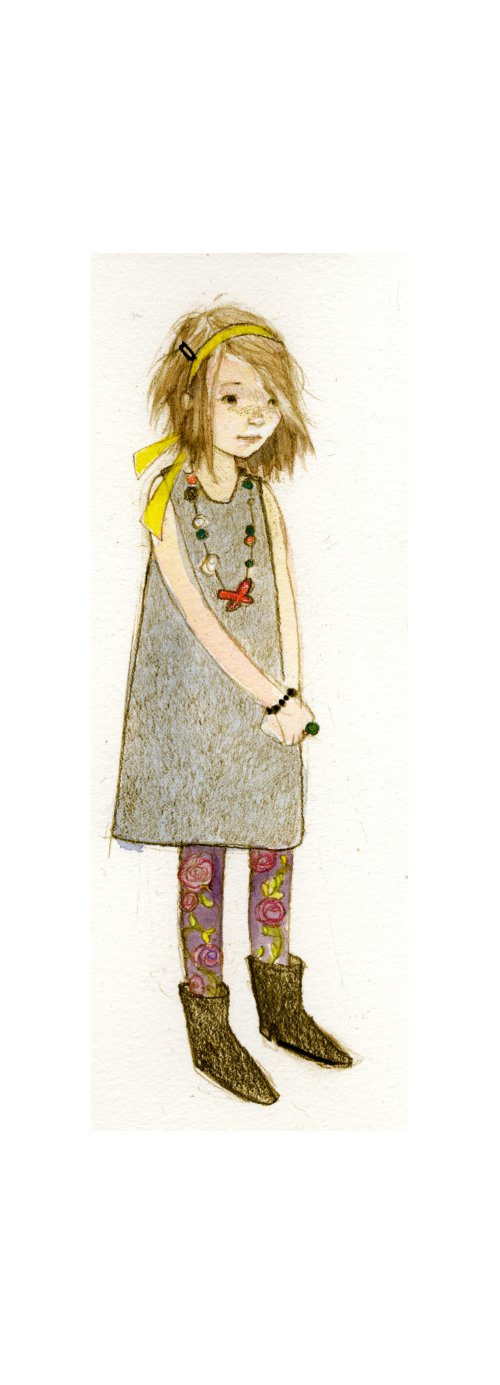
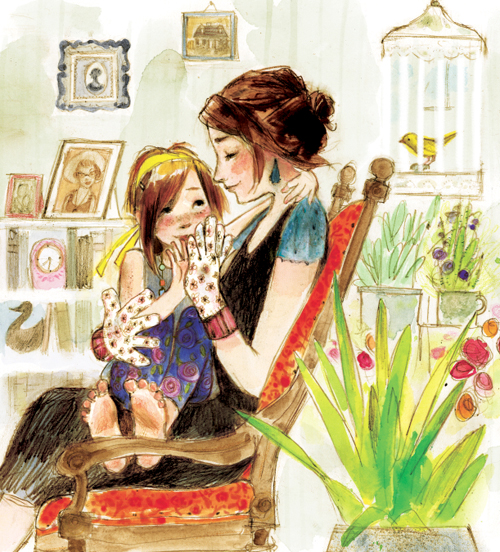
Finally, the book I am SO EXCITED to reveal a little of is Just Being Audrey by Margaret Cardillo, which is a biography for children about Audrey Hepburn’s life. It’s been such a secret, and now I have permission to share!
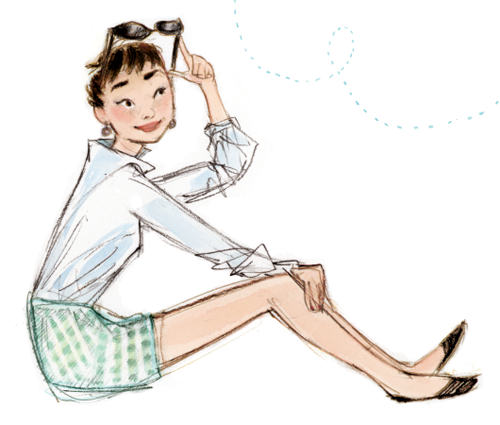



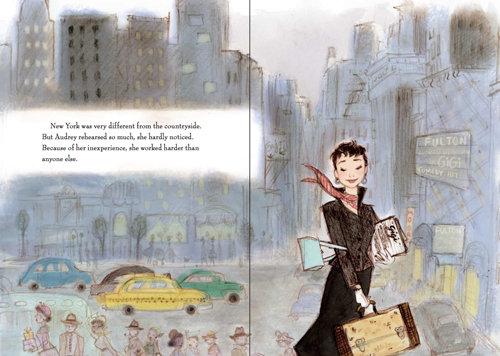
I could talk about Audrey’s legacy and the making of this book for days. In summary: I fell in love with this lady and her triumphant life story, and I was honored to express it in my own way.
 Our coffee has brewed, the mint tea has steeped, and we’re ready to get a bit more detailed. I thank Julia again for stopping by.
Our coffee has brewed, the mint tea has steeped, and we’re ready to get a bit more detailed. I thank Julia again for stopping by.
1. 7-Imp: What exactly is your process when you are illustrating a book? You can start wherever you’d like when answering: getting initial ideas, starting to illustrate, or even what it’s like under deadline, etc. Do you outline a great deal of the book before you illustrate or just let your muse lead you on and see where you end up?
Julia: I’m still learning how to make a book. I always wish I could say that right away I make tidy little thumbnails like they taught us to do in art school. What I really do is make a big mess, read the manuscript a million times, and whine a lot until I SEE the book. I also found that you can’t set aside time for concepting or nothing will happen but this: “Look at that white paper! There’s nothing on it! Should I sharpen my pencil? I want a cookie.”
STEP#1: Daydream & Make Pies

The best way to start for me is to read the manuscript and daydream about it in the background. I kind of send out a little locator into time and space while I do my other work, cook dinner, or make a lemon pie.

STEP#2: Style, Palette, Voice

I wonder a lot about where/when will this story be. What colors live there, too. I spend a lot of time collecting clues and reference from the author’s voice in the story and playing with colored pencils and line, trying to figure out {how} to let them suit that certain voice. I am always playing around with realism vs. stylization for that voice. Sometimes I do some personal unrelated work during this time to experiment. When I was stuck on starting Grandma’s Gloves, I wrote a letter from the little girl to her grandma to help me get to know her better. I collect tons of googled and cut-out pictures, relevant words, and color palettes around that feeling.
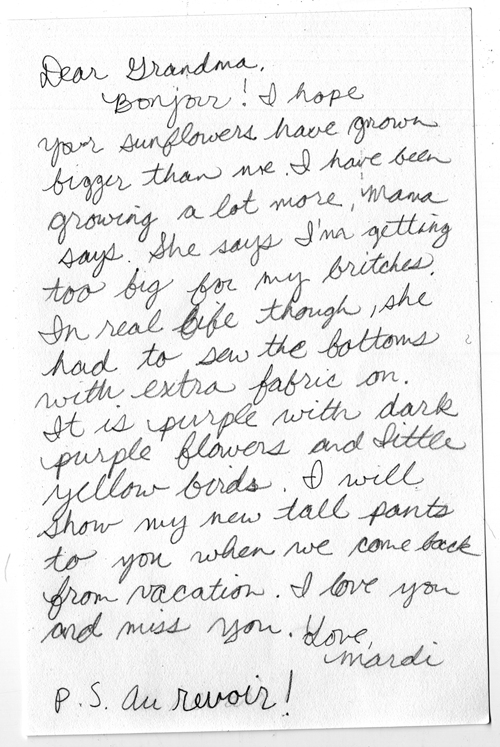
Step#3: Character Design
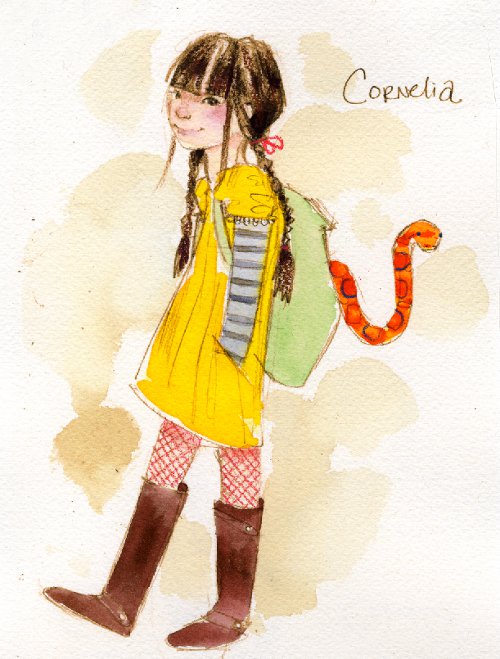
Finally, when I can SEE the story in my mind, it’s an exciting time. Then I do the most fun and easy part for me: try to make a real person who might live in the story. I wrap them in layers of the visual palette, and it’s a character design! I sometimes do sketches of the places they live in, too.

Step#4: Paginate the text
Once I love this new place and the people who live there, I can go ahead with making the book.
First I print out the manuscript and make little notes in the margins and paginate according to the flow for a page turn. Some scenes are SO clear that the rest of the book takes its cue from that spread, and I’ll scribble that scene out right on the manuscript while I’m reading.
Step#5: Sketchy scenes
Then, it’s drawing time. I’ll make lots of loose squiggly drawings at any size they want to be for each “scene.” They are so messy that sometimes they don’t make sense to anyone but me.
Step#6: Thumbnails, finally.
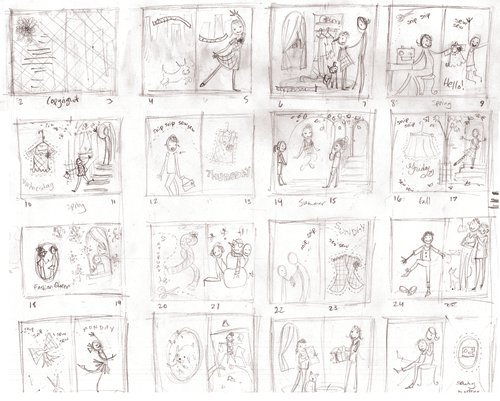
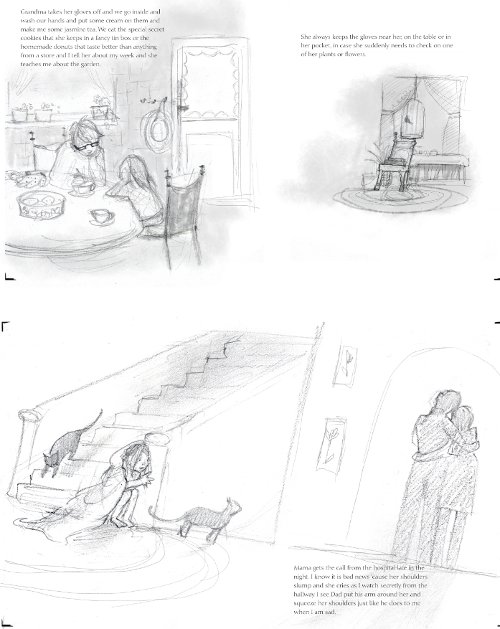
Then I make my official thumbnail sketches so I can show something to my art director and editor. Thumbnails are a great way to see your ideas on a small scale and to make sure the book is designed and working as a whole. I start adding text in at this time, and sometimes have to rearrange what the spread looks like for the text.
Step#7: Final Art
Once the thumbnails are put into a formal layout by the designer, and it’s approved by my art director and editor, I move to final art. Making final art is still a mystery to me, you never know where you’ll end up by the end!

My process is multimedia. I trace the printouts of the blown-up-to-scale thumbnails very loosely onto watercolor paper. Then I draw my final work in pencil, scan it, print it out again on watercolor paper sometimes and paint/color on that — or just paint directly onto my drawing, scan it back in, and put the line layer back over the painted piece in Photoshop to enhance the line. Then I finish it by collaging all the pieces together in Photoshop and controlling the color and line weight. It’s kind of like directing an orchestra, pushing and pulling darks and lights forward, working with color saturation, adding in pattern. I play until it’s done.
2. 7-Imp: Describe your studio or usual work space.
Julia: We are in the middle of designing shelving and walls, so I just have two tables right now. It’s always tidy for visitors, and it usually explodes again the minute they leave. My cat, Seri, is usually sprawled belly up on my book dummies.
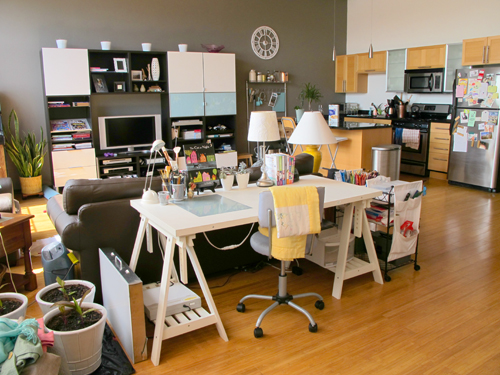
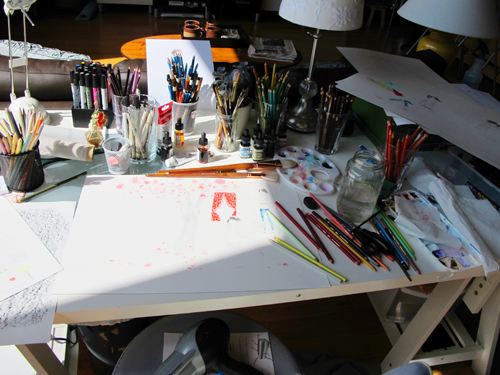

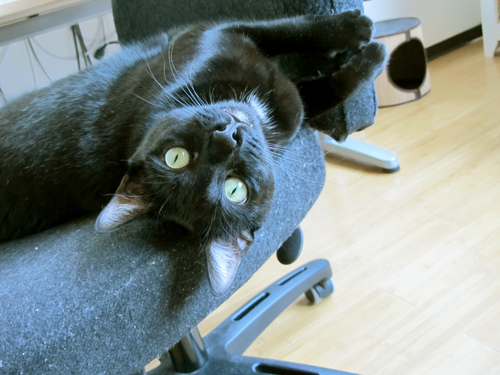
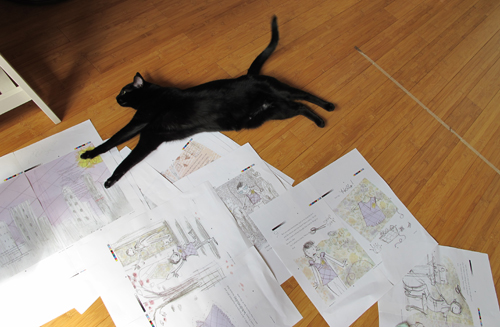
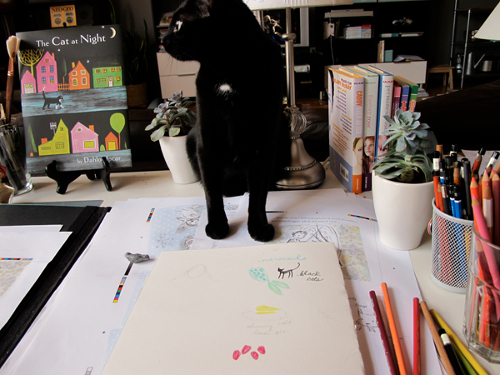
There are always weird objects on my desk, like lemons or eggplants, which I loved the color of, carried in, and forgot to return to its place. Always a dangerous guessing game of half-full water glasses all over (1 in 3 chance I am drinking diluted Dr. Martin’s ink or cat backwash). I have every color Prismacolor makes in pencils, two little cactuses, lots of light. My grandmother’s old perfume bottle filled with bath salt. Flowers in a vase on good week.


3. 7-Imp: As a book lover, it interests me: What books or authors and/or illustrators influenced you as an early reader?
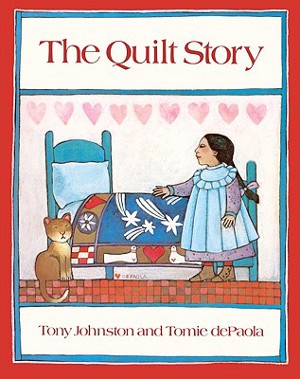 Julia: The poetry in OxCart Man by Donald Hall and Barbara Cooney. Tomie DePaola’s Quilt Story –- I love the passage of time in that book and his iconographic style. His work was always lying around our house, as was the work of Chris Van Allsburg, Beatrix Potter, Ludwig Bemelmans, and Laura Ingalls Wilder. James Marshall (Miss Nelson!) and the Provensens were regulars at bed time, too. My parents always had books of Norman Rockwell hanging around. Maira Kalman’s Max books were big childhood influence.
Julia: The poetry in OxCart Man by Donald Hall and Barbara Cooney. Tomie DePaola’s Quilt Story –- I love the passage of time in that book and his iconographic style. His work was always lying around our house, as was the work of Chris Van Allsburg, Beatrix Potter, Ludwig Bemelmans, and Laura Ingalls Wilder. James Marshall (Miss Nelson!) and the Provensens were regulars at bed time, too. My parents always had books of Norman Rockwell hanging around. Maira Kalman’s Max books were big childhood influence.
4. 7-Imp: If you could have three (living) illustrators or writers—whom you have not yet met—over for coffee or a glass of rich, red wine, whom would you choose?
Julia: Wine please — with Marc Simont, Lauren Child, Melissa Sweet.
May I be granted a ghostly, posthumous illustration red wine visit, too? Ludwig Bemelmans (I bet he would draw funny things on his napkin), Jack Potter, Vera Neumann.
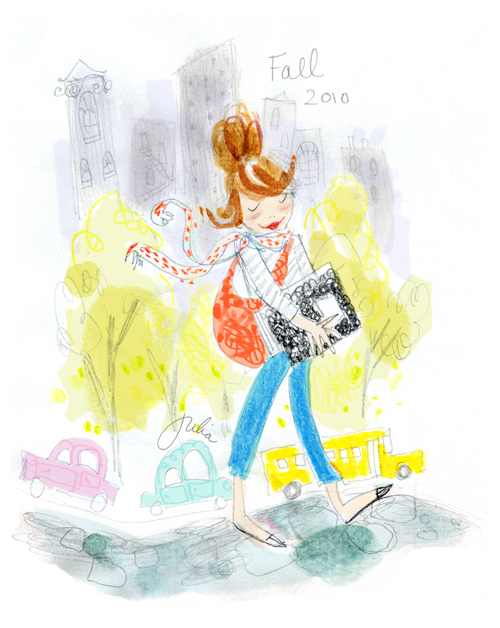
5. 7-Imp: What is currently in rotation on your iPod or loaded in your CD player? Do you listen to music while you create books?
Julia: I can’t draw without it. So, yes! Sometimes I stress out if I’ve been given the OK to go to final art, and my music is stale. (I suck the life out of music on repeat if I like it.) Currently endangered songs: “My Girls” by Animal Collective, “Young Friend” by Brooke Waggoner, and “All Joy Wills Eternity” by Christopher Theofanidis. The current book is requiring a lot of jazz: my favorite is Django Reinhardt, supplemented by my “Marian McPartland” Pandora station. I grew up in a music-loving family and always drew to whatever my parents had on. Music is extremely entangled with my process; most of my characters have been born out of a good piece of music. They just pop into vision when my ears are happy. Art is kind of my reaction TO music.
The soundtrack to this summer: Jónsi’s dreamy new album, Go (from Sigur Rós).

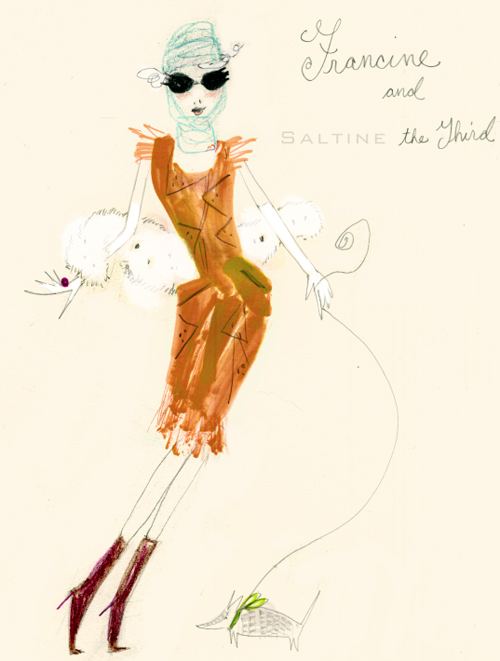

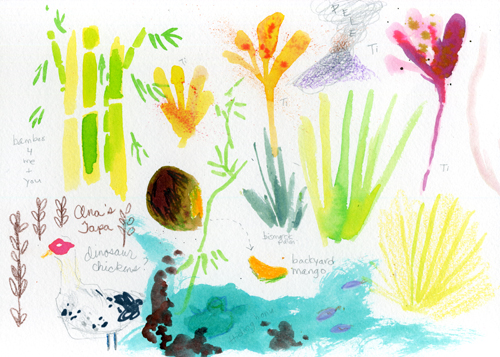

6. 7-Imp: What’s one thing that most people don’t know about you?
Julia: I am currently working on my aversion to city driving (highway accident followed by pedestrian life in the city). So far, so good. We bought a GPS and the British voice, Emily, is being a good sport about it. I read Audrey Hepburn stopped driving altogether after an accident, too. That’s why she rode her bicycle all over! Audrey’s inspiring me to tackle it.

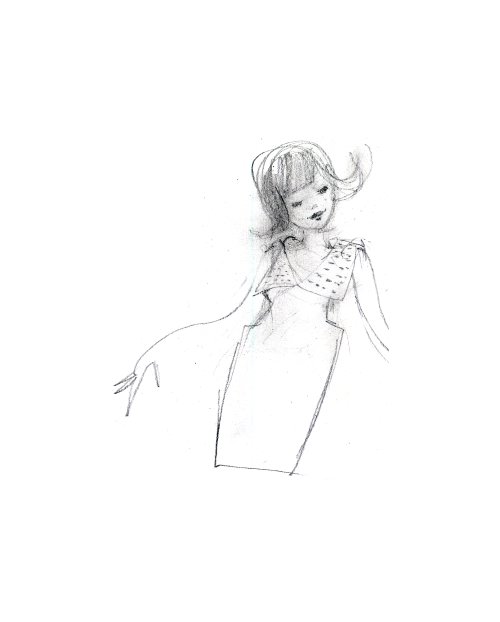
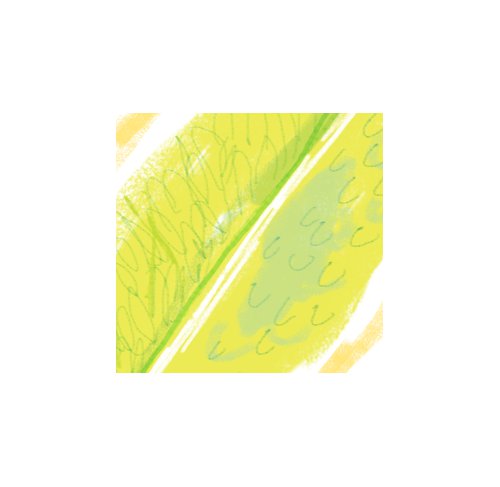

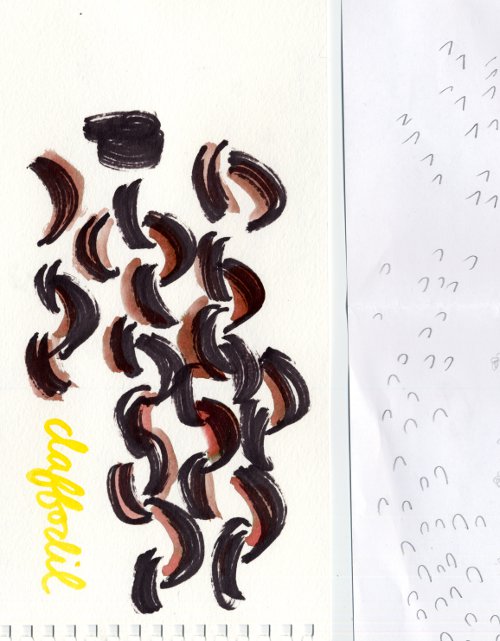
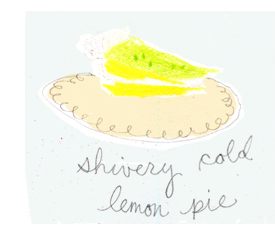 7. 7-Imp: Is there something you wish interviewers would ask you — but never do? Feel free to ask and respond here.
7. 7-Imp: Is there something you wish interviewers would ask you — but never do? Feel free to ask and respond here.
Julia: Yes: What are some magical jobs (besides what you are working on) that your greedy little illustrator heart is pining for right now?
Answer: To find a home for my “fashion ladies”; to license my work for stationery, toys, and homeware. Designing children’s clothing would be the most excellent gig!! Aaaa! I also badly want to illustrate a cookbook. I’d love to teach one day.

7-Imp: What is your favorite word?
Julia: “Cloud.”
7-Imp: What is your least favorite word?
Julia: “Cute.”
7-Imp: What turns you on creatively, spiritually or emotionally?
Julia: Walking into an old-fashioned house, COLOR, nature, cosmic talks with the Denos siblings (I have four), my husband’s character designs, food (art of, growing of, cooking of, sharing of, eating of), making art with kids, illustration blogosphere, the paranormal (yes I love all those terrible shows), the stories old people tell, store-front windows, runway fashion, the biography section in libraries, genealogy, MUSIC, dusk, singing in harmony, open hearts, possibility, facing a challenge, autumn in the city.
7-Imp: What turns you off?
Julia: Any place without windows, negativity, mean people, strip malls, the smell of asphalt, stupid color choices, yucky typography, junk t.v. (not including the paranormal stuff), too much advertising, too much computer, gym class, tuna casserole, revenge, lack of salad with dinner.
7-Imp: What is your favorite curse word? (optional)
Julia: F-dash-dash-dash word on rare and selective occasions.
7-Imp: What sound or noise do you love?
Julia: A thunderstorm slowly rumbling in.
7-Imp: What sound or noise do you hate?
Julia: That hocking-a-loogie on the sidewalk routine. Unbelievable!
7-Imp: What profession other than your own would you like to attempt?
Julia: Chef, archeologist, farmer, textile designer, color forecaster, back up singer.
7-Imp: What profession would you not like to do?
Julia: Truck driver.
7-Imp: If Heaven exists, what would you like to hear God say when you arrive at the Pearly Gates?
Julia: “Welcome home! Wasn’t that a good story?”
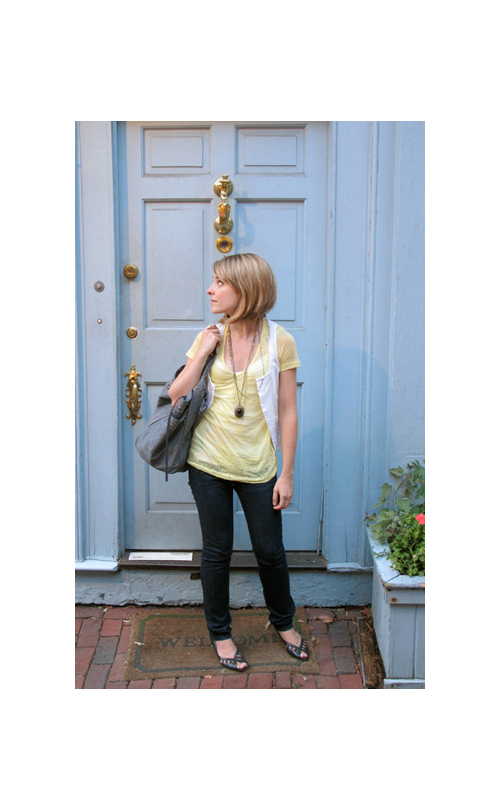
All artwork and photos used with permission of Julia Denos. All rights reserved.
The spiffy and slightly sinister gentleman introducing the Pivot Questionnaire is Alfred, © 2009 Matt Phelan. Thanks to Matt, Alfred now lives permanently at 7-Imp and is always waiting to throw the Pivot Questionnaire at folks.

One of those insanely detailed interviews which I wish could have gone on for another hour or two. Thanks so much to Julia Denos for sharing so much art and words and so many photos and, of course, to you, Jules, for all the usual.
If I had to imagine a subject perfectly suited for Julia’s lean-lithe-protagonist style, it’d be Audrey Hepburn. That’s gonna be some book!
(Two asides: (1) Neat little “7-Imp in blue, interviewee in black” effect. (2) I noticed from visiting Julia’s blog that you apparently made her wish she’d asked for coffee instead of mint tea. Ha — another convert!)
Fantastic visit, Julia and Jules! This post is a feast for the eyes. Lovely.
And Julia- we listen to British Jane on ours! Love her! She makes everything sound so civilized…
Great interview! I love Julia’s work. That Audrey Hepburn book looks fantastic. Also, I’m planning on stealing the idea of sorting pencils by color…
Wow- SO much fun to read and see this! Julia is such a joyous inspiration. I can’t help but think of the Dr Seuss quote- ‘Oh- the places you’ll go!’ 🙂
Such an excellent interview, Julia (and Jules)!!! It was great to read about your process…I have been curious about it (you sure do have a lot of final art steps!). The art from your upcoming Audrey book is SO lovely–know a bunch of people who will be needing a copy of that one! And, after seeing all the photos of your town, I think I might need to move there 🙂
What a fantastic interview. I loved all the doodles and pictures! I got a happy little ache inside when I saw the pictures for “Just Being Audrey.”
All these illustrations seem like the perfect books to pour over and look at all the little details and colors. I think I’m in love.
Oooh! This is a great feature on a lovely person. I’ve had the opportunity to work with Julia a couple of times and have absolutely fallen in love with her work. I like the way you interspersed her art throughout the interview.
LOVE her work! Simply gorgeous…. Great post!
[…] not discussed in Betsy’s list. And that would be Erica Perl’s Dotty, illustrated by Julia Denos, who gets better with every book she […]
[…] Seven Questions Over Breakfast with Julia Denos(with visits from authors Cecil Castellucci and Erica… September 7th, 2010    by jules […]
Wonderful blog, great interview, lovely inspiring work by Ms. Denos. Made my day– many thanks and all the best to both Imp and Artist!
[…] behind the books that my children love so much. You can get to know her a lot better here on this wonderfully thorough interview. Thanks so much Julia for this great […]
Hey Julia, yesterday I found an abandoned tiny (about 1,5 month old) black cat with white spot of hair on his chest. Later when I came home, I coincidentally found your page and found out that you are an illustrator too and that you have a black cat with white spot on his chest too. We seem to be sisters in cats as well as in profession, how about that?
I d send you this little guy so you and Serif, who is btw magically beautiful would train him, if we would not be from the other side of Atlantic. I wish you a lot of fun and joy at our magically beautiful work. Mish
[…] The highlight of the book has to be Denos’ outstanding illustrations that capture in their whimsical, hand-crafted appearance, all of the creative energy of the narrative. I love the collage elements and the dreamy watercolours and scribbly lines. It all fits together in one of those wonderful, rare, “this is the perfect illustrator for this book” packages. Read more about Denos and her artwork over at 7imp in this wonderful interview. […]
, , , , , .
[…] had been tucked away. I had drawn it years before and named him “In-Between-Gray” and Jules Danielson had encouraged me to write about him. Maybe he was familiar with Swatch, maybe could help me hunt […]
[…] I saw this image, created by author-illustrator Julia Denos, on Instagram this week, and I secured her permission to share it here. I like it. It makes me […]